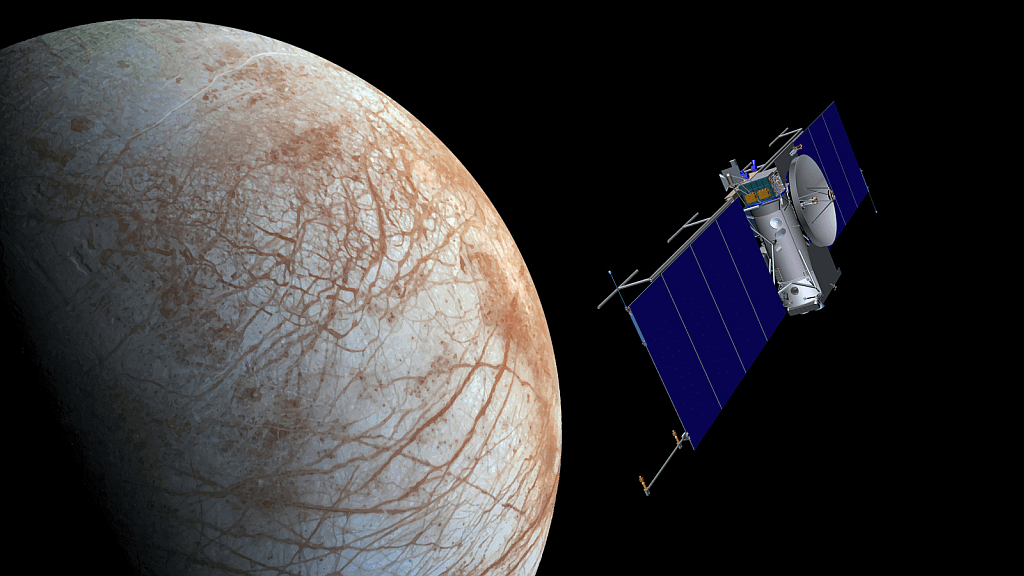Jupiter’s moon Europa is a juicy target for exploration. Beneath its surface of ice there’s a warm salty, ocean. Or potentially, at least. And if Earth is our guide, wherever you find a warm, salty, ocean, you find life. But finding it requires a dedicated, and unique, mission.
If each of the bodies in our Solar System weren’t so different from each other, we could just have one or two types of missions. Things would be much easier, but also much more boring. But Europa isn’t boring, and it won’t be easy to explore. Exploring it will require a complex, custom mission. That means expensive.
NASA’s proposed mission to Europa is called the Europa Clipper. It’s been in the works for a few years now. But as the mission takes shape, and as the science gets worked out, a parallel process of budget wrangling is also ongoing. And as reported by SpaceNews.com there could be bad news incoming for the first-ever mission to Europa.

At issue is next year’s funding for the Europa Clipper. Officials with NASA’s Outer Planets Assessment Group are looking for ways to economize and cut costs for Fiscal Year (FY) 2017, while still staying on track for a mission launch in 2022.
According to Bob Pappalardo, Europa Clipper’s project scientist at the Jet Propulsion Laboratory, funding will be squeezed in 2017. “There is this squeeze in FY17 that we have,” said Pappalardo. “We’re asking the instrument teams and various other aspects of the project, given that squeeze, what will it take in the out years to maintain that ’22 launch.”
As for the actual dollar amounts, there are different numbers floating around, and they don’t all jive with each other. In 2016, the Europa Mission received $175 million from Congress, but in the administration’s budget proposal for 2017, they only requested $49.6 million.
There’s clearly some uncertainty in these numbers, and that uncertainty is reflected in Congress, too. An FY 2017 House bill earmarks $260 million for the Europa mission. And the Senate has crafted a bill in support of the mission, but doesn’t allocate any funding for it. Neither the Senate nor the Congress has passed their bills.
This is not the first time that a mis-alignment has appeared between NASA and the different levels of government when it comes to funding. It’s pretty common. It’s also pretty common for the higher level of funding to prevail. But it’s odd that NASA’s requested amount is so low. NASA’s own low figure of $49.6 million is fuelling the perception that they themselves are losing interest in the Europa Clipper.
But SpaceNews.com is reporting that that is not the case. According to Curt Niebur, NASA’s program scientist for the Europa mission, “Everyone is aware of how supportive and generous Congress has been of this mission, and I’m happy to say that that support and encouragement is now shared by the administration, and by NASA as well. Everybody is on board the Europa Clipper and getting this mission to the launch pad as soon as our technical challenges and our budget will allow.”
What all this seems to mean is that the initial science and instrumentation for the mission will be maintained, but no additional capacity will be added. NASA is no longer considering things like free-flying probes to measure the plumes of water ice coming off the moon. According to Niebur, “The additional science value provided by these additions was not commensurate with the associated impact to resources, to accommodation, to cost. There just wasn’t enough science there to balance that out.”
The Europa Clipper will be a direct shot to Europa, without any gravity assist on the way. It will likely be powered by the Space Launch System. The main goal of the mission is to learn more about the icy moon’s potential habitability. There are tantalizing clues that it has an ocean about 100 km thick, kept warm by the gravity-tidal interactions with Jupiter, and possibly by radioactive decay in the rocky mantle. There’s also some evidence that the composition of the sub-surface ocean is similar to Earth’s.
Mars is a fascinating target, no doubt about it. But as far as harbouring life, Europa might be a better bet. Europa’s warm, salty ocean versus Mar’s dry, cold surface? A lot of resources have been spent studying Mars, and the Europa mission represents a shift in resources in that regard.
It’s unfortunate that a few tens of million dollars here or there can hamper our search for life beyond Earth. But the USA is a democracy, so that’s the way it is. These discrepancies and possible disputes between NASA and the different levels of government may seem disconcerting, but that’s the way these things get done.
At least we hope it is.
Sources: SpaceNews.com
Europa on Universe Today:


The US is a Constitutional Republic.
US Congress has made law which requires NASA to send 50 tons of payload to Europa’s orbit and surface. That’s like the sum of mass of all the Apollo Lunar Modules! Or like 20 Cassini-Huygens. And Congress wants to provide a quarter of a billion a year in funding, beside the two SLS launches. This has stronger political support than any space mission has had in 50 years. It is the greatest robotic mission of all time, by far. Several kilometer deep drilling and sample return to Earth would just be a part of this total exploration of Europa in the 2020s.
But NASA doesn’t want it. And there’s no enthusiasm in the open space community. Why?
Since I haven’t looked at the proposed budget(s) recently & don’t actually know — Is it possible the low number is NASA’s way of saying (in budget-ese) that they can’t have everything they want, so they’re willing to sacrifice the EC, rather than some other project(s)? Maybe the missing funds are allocated somewhere else they think is more time-sensitive/productive?
Even THAT suggests that maybe this isn’t the most import mission on the docket, that maybe they think they could launch this mission any old time they happen to have the funding, whether it’s five years from now, or fifty. NOT a ringing administrative endorsement, for sure, regardless of the PR-speak offered in defense.
I suppose only a few insiders can truly judge the politics of this. But Europa has stronger support from US Congress than any other space mission since Apollo. A new president wants a spectacular flagship mission within 8 years of administration, a Europa mission can deliver that. It plays on the alien life myth which is very popular. SLS will happen, it can fly three times with engines already flight proven and in storage. It will be the most reliable and politically most supported launcher ever developed. And two of those three sure fire launches are given to a Europa mission by law. And scientifically it is a very good priority to take a look at an icy moon, there are about as many of them as there are planets.
If NASA refuses to spend 1.4% of its budget next year on developing a Europa mission, then maybe NASA is in need of a great reform. DoD is maybe are much better equipped to take care of space exploration than what NASA is. Space science could be taken care of by the universities. Space technology by the market. NASA has matured into a chaotic improductive bureaucracy without any priorities or plans. If NASA cannot even accept the leadership of Congress on this issue, the best thing to do is obviously to disband the organization.
We have to remember that people like Christopher Kraft (For whom the Mission Control Center at the Johnson Space Center is named) are few and far between. Breaking up NASA is not the solution. Finding another person like Christopher Kraft is the solution.
Does somebody have an idea how to attract such a person to NASA when so many want to go to Silicone Valley?
So maybe the solution is to let the NASA staff go to Silicon Valley and let private space and universities (and the military as in Russia and China) take care of space exploration, science and technology. NASA’s top skilled employees would be much more efficiently organized in Silicon Valley than in a government bureaucracy without any kind of plan, priority or leadership. NASA administration now even bites the very very generous Congressional hand it is totally dependent on and which points towards Europa, giving them the largest and most expensive launcher in the world. Two of them. But NASA doesn’t like. Too bad.
Picking up a boulder from a meteoroid and put it in Lunar orbit. Well, we’ll see about that. NASA has deep problems and big problems (to paraphrase deep space and big data). It’s survival doesn’t look politically viable any more. NASA has a great chance right now with the Europa mission, putting the first few SLS to something useful and affordable instead of risking human life on a meteoroid boulder mission. But they seem to be is wasting this opportunity! When this presidential administration changes, NASA will have their last chance to quickly reform themselves, or someone else will reform them from the outside and that won’t be pretty.
I think it is time for a name selection for the on board computer of the Europa Clipper.
Heuristic ALgorithmic 9000 computer is the obvious choice, with other possibilities.
Hadoop Advanced Logic 9000 and Hadoop Artificial Lucidity 10000 are more up to date.
Up to date probably does not matter. The first US Navy nuclear powered submarine was called the Nautilus.
Robert Fulton built the first “Nautilus” submarine in 1800, and 20,000 Leagues Under the Sea was written “later” in 1870.
FarAwayLongAgo what I understand between the lines is that you are proposing turning NASA over to someone like Elon Musk.
It might not be such a bad idea.
Reply #1409 in this thread has the slides of a recent science update for the mission. Slide 2 has an image of a familiar monolith. Is that the mission’s symbol? 🙂 http://forum.nasaspaceflight.com/index.php?topic=27871.0
Elon will do his thing anyway. Stubborn unstoppable guy. Have they renamed Mars “Planet Musk”?